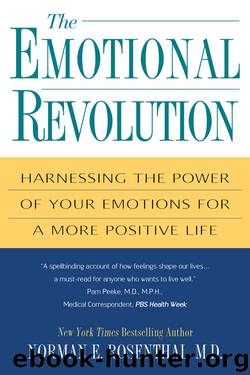The Emotional Revolution by Norman E. Rosenthal

Author:Norman E. Rosenthal
Language: eng
Format: epub
Publisher: Kensington
Published: 2012-10-04T04:00:00+00:00
Step 8: Use Exposure and Relaxation
Anger-management researchers have adapted methods from effective anxiety treatments, reasoning that both anger and anxiety are unpleasant emotions with a state of high arousal. Joseph Wolpe, a pioneer in behavioral-therapy research, was the first to reason that it is impossible to feel highly aroused and relaxed at the same time.64 If you get a person to relax while at the same time exposing him to an unpleasant stimulus, he suggested, you might be able to decondition him. The nervous system can be taught to greet that stimulus with relaxation, not the old unpleasant emotions.
In research since then, attempts to treat anger by simply teaching a person how to relax have been shown to be much less effective than combining relaxation with exposure to the trigger stimuli.65 The triggers differed from person to person. The relaxation techniques included slow, deep abdominal breathing, contracting and relaxing various muscle groups, and several meditative techniques. Many currently available books are devoted to teaching these relaxation techniques.
Coupling relaxation with anger triggers is difficult to practice on one’s own because the stimuli are so unpleasant that people with anger problems are understandably reluctant to expose themselves to the pain of reliving them. For this reason, most people don’t like to do this sort of work at home. Those with serious anger problems are advised to consult a therapist with some expertise in anger management. A skillful therapist can be very helpful both in pointing out your strengths and in putting the anger-inducing insults in perspective before starting the exposure therapy. Essentially the treatment involves thinking about the anger triggers, feeling the bodily sensations of anger, and then going through a relaxation exercise that helps you settle down those angry feelings and bodily sensations while still holding in mind the unpleasant situation.
Whether you work on your anger with a professional or on your own, remember that every time you get triggered is an opportunity to practice. So, an ideal time for Ken to work on his anger at his boss might be while he is sitting at his desk, shoulders hunched, and jaw clenched, ruminating over the latest indignities. For example, he could think about his boss’s behavior, breathe in deeply, using his diaphragm, and murmur to himself, “Be calm.” On the exhalation he could say, “Let the anger go,” and visualize it flowing out of his system in a stream of colored light. This exercise can be repeated as long and as often as needed.
Letting go of your anger is important to the success of this exercise. If you are not vigilant, you can easily lapse into your angry thoughts again, which would make the exercise worthless.
Download
This site does not store any files on its server. We only index and link to content provided by other sites. Please contact the content providers to delete copyright contents if any and email us, we'll remove relevant links or contents immediately.
Should I Stay or Should I Go? by Ramani Durvasula(7568)
Why We Sleep: Unlocking the Power of Sleep and Dreams by Matthew Walker(6618)
Fear by Osho(4662)
Flow by Mihaly Csikszentmihalyi(4639)
Rising Strong by Brene Brown(4380)
Why We Sleep by Matthew Walker(4361)
The Hacking of the American Mind by Robert H. Lustig(4319)
How to Change Your Mind by Michael Pollan(4292)
Too Much and Not the Mood by Durga Chew-Bose(4277)
Lost Connections by Johann Hari(4098)
He's Just Not That Into You by Greg Behrendt & Liz Tuccillo(3834)
Evolve Your Brain by Joe Dispenza(3613)
The Courage to Be Disliked by Ichiro Kishimi & Fumitake Koga(3417)
Crazy Is My Superpower by A.J. Mendez Brooks(3332)
In Cold Blood by Truman Capote(3311)
Resisting Happiness by Matthew Kelly(3303)
What If This Were Enough? by Heather Havrilesky(3275)
The Book of Human Emotions by Tiffany Watt Smith(3238)
Descartes' Error by Antonio Damasio(3231)
